Abstract
Swimming speeds and flagellar rotation rates of individual free-swimming Vibrio alginolyticus cells were measured simultaneously by laser dark-field microscopy at 25, 30, and 35 degrees C. A roughly linear relation between swimming speed and flagellar rotation rate was observed. The ratio of swimming speed to flagellar rotation rate was 0.113 microns, which indicated that a cell progressed by 7% of pitch of flagellar helix during one flagellar rotation. At each temperature, however, swimming speed had a tendency to saturate at high flagellar rotation rate. That is, the cell with a faster-rotating flagellum did not always swim faster. To analyze the bacterial motion, we proposed a model in which the torque characteristics of the flagellar motor were considered. The model could be analytically solved, and it qualitatively explained the experimental results. The discrepancy between the experimental and the calculated ratios of swimming speed to flagellar rotation rate was about 20%. The apparent saturation in swimming speed was considered to be caused by shorter flagella that rotated faster but produced less propelling force.
Full text
PDF
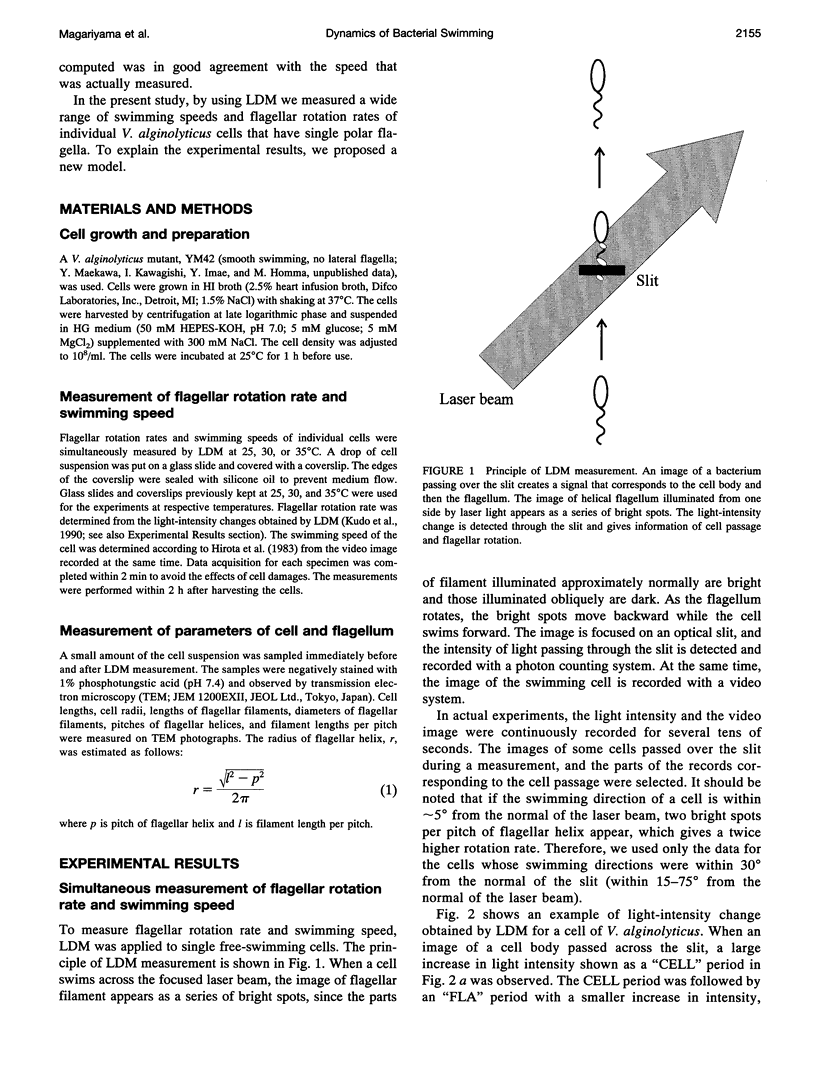
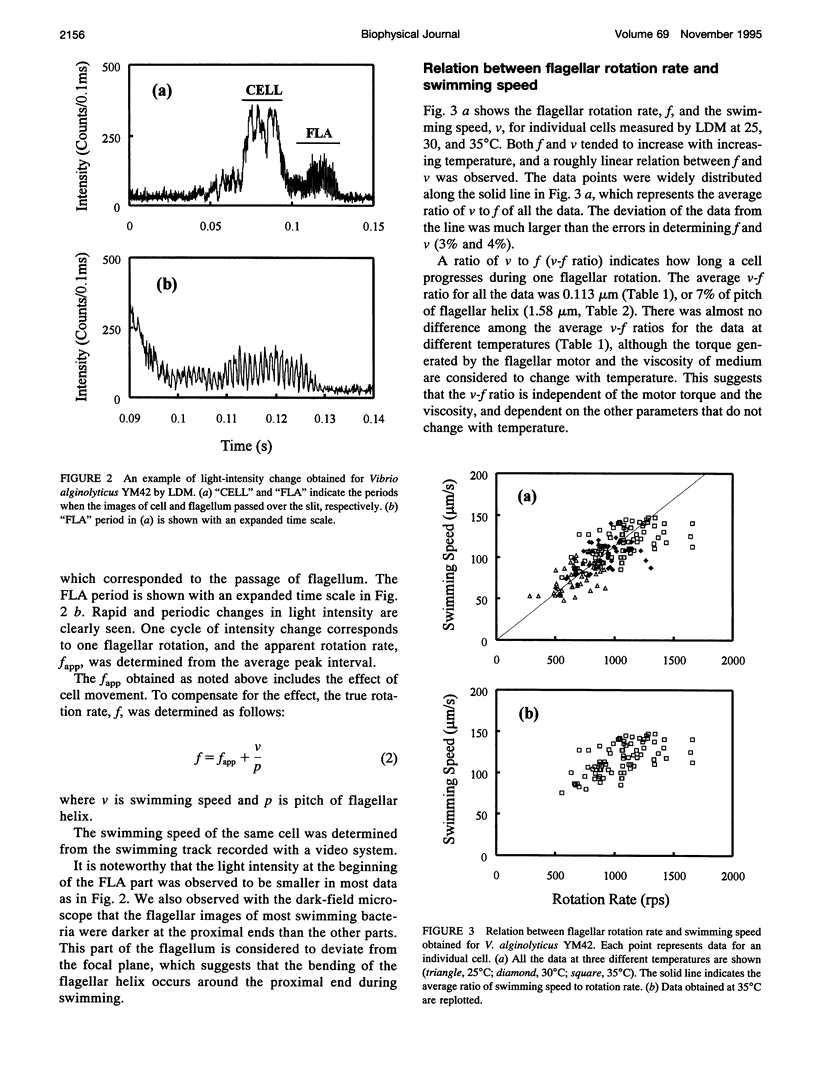
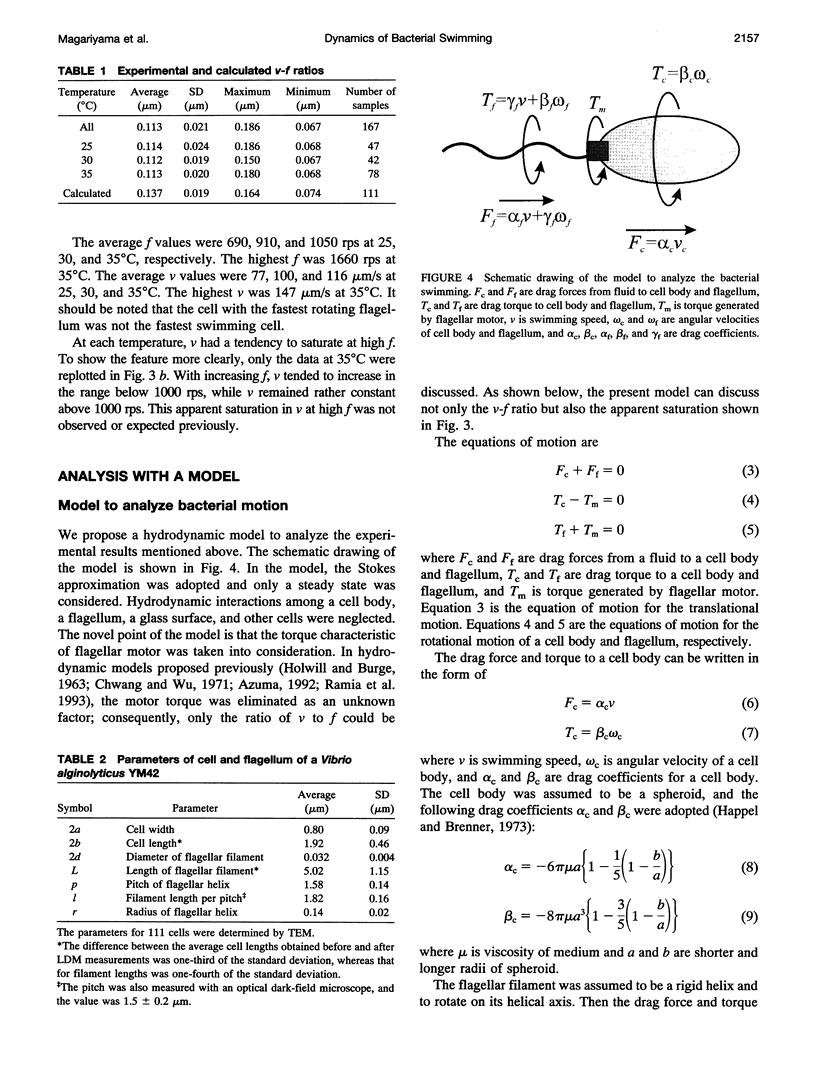


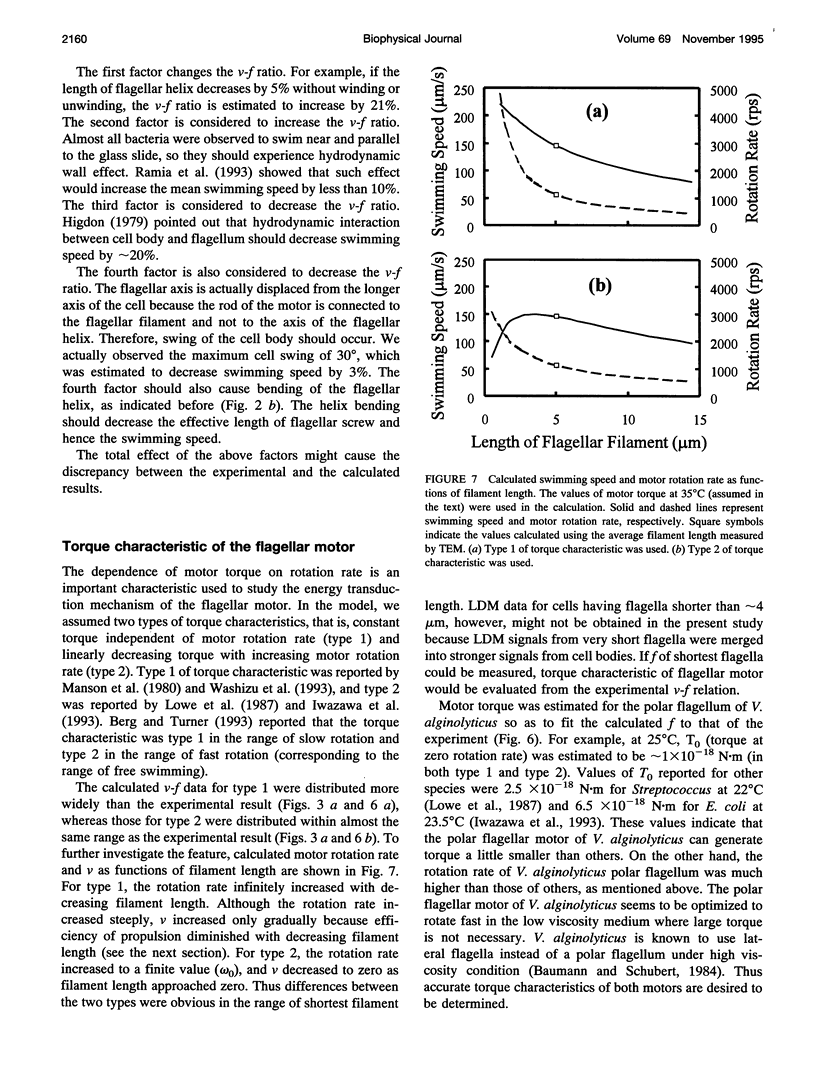
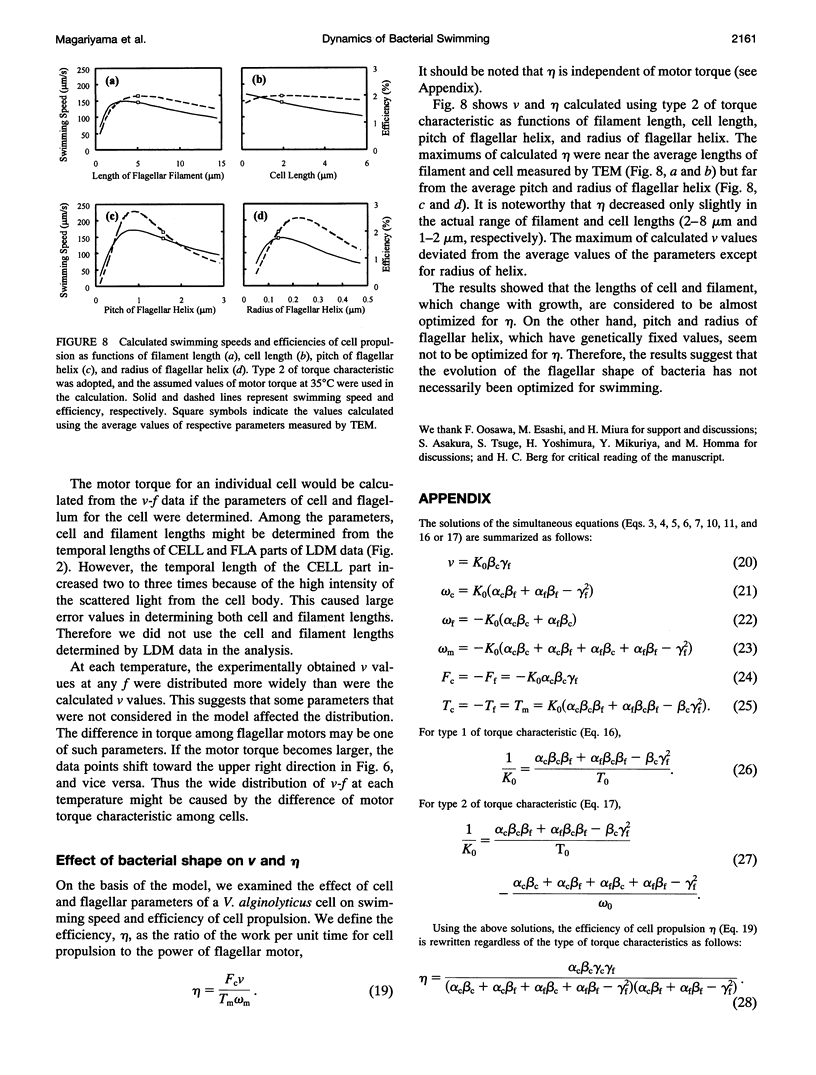

Images in this article
Selected References
These references are in PubMed. This may not be the complete list of references from this article.
- Berg H. C., Turner L. Torque generated by the flagellar motor of Escherichia coli. Biophys J. 1993 Nov;65(5):2201–2216. doi: 10.1016/S0006-3495(93)81278-5. [DOI] [PMC free article] [PubMed] [Google Scholar]
- Blair D. F., Berg H. C. The MotA protein of E. coli is a proton-conducting component of the flagellar motor. Cell. 1990 Feb 9;60(3):439–449. doi: 10.1016/0092-8674(90)90595-6. [DOI] [PubMed] [Google Scholar]
- Chwang A. T., Wu T. Y. A note on the helical movement of micro-organisms. Proc R Soc Lond B Biol Sci. 1971 Aug 3;178(1052):327–346. doi: 10.1098/rspb.1971.0068. [DOI] [PubMed] [Google Scholar]
- Francis N. R., Sosinsky G. E., Thomas D., DeRosier D. J. Isolation, characterization and structure of bacterial flagellar motors containing the switch complex. J Mol Biol. 1994 Jan 28;235(4):1261–1270. doi: 10.1006/jmbi.1994.1079. [DOI] [PubMed] [Google Scholar]
- Gibbons I. R. Cilia and flagella of eukaryotes. J Cell Biol. 1981 Dec;91(3 Pt 2):107s–124s. doi: 10.1083/jcb.91.3.107s. [DOI] [PMC free article] [PubMed] [Google Scholar]
- HOLWILL M. E., BURGE R. E. A hydrodynamic study of the motility of flagellated bacteria. Arch Biochem Biophys. 1963 May;101:249–260. doi: 10.1016/s0003-9861(63)80010-7. [DOI] [PubMed] [Google Scholar]
- Hirota N., Imae Y. Na+-driven flagellar motors of an alkalophilic Bacillus strain YN-1. J Biol Chem. 1983 Sep 10;258(17):10577–10581. [PubMed] [Google Scholar]
- Iwazawa J., Imae Y., Kobayasi S. Study of the torque of the bacterial flagellar motor using a rotating electric field. Biophys J. 1993 Mar;64(3):925–933. doi: 10.1016/S0006-3495(93)81454-1. [DOI] [PMC free article] [PubMed] [Google Scholar]
- Kudo S., Magariyama Y., Aizawa S. Abrupt changes in flagellar rotation observed by laser dark-field microscopy. Nature. 1990 Aug 16;346(6285):677–680. doi: 10.1038/346677a0. [DOI] [PubMed] [Google Scholar]
- Läuger P. Torque and rotation rate of the bacterial flagellar motor. Biophys J. 1988 Jan;53(1):53–65. doi: 10.1016/S0006-3495(88)83065-0. [DOI] [PMC free article] [PubMed] [Google Scholar]
- Magariyama Y., Sugiyama S., Muramoto K., Maekawa Y., Kawagishi I., Imae Y., Kudo S. Very fast flagellar rotation. Nature. 1994 Oct 27;371(6500):752–752. doi: 10.1038/371752b0. [DOI] [PubMed] [Google Scholar]
- Manson M. D., Tedesco P. M., Berg H. C. Energetics of flagellar rotation in bacteria. J Mol Biol. 1980 Apr 15;138(3):541–561. doi: 10.1016/s0022-2836(80)80017-9. [DOI] [PubMed] [Google Scholar]
- Manson M. D., Tedesco P., Berg H. C., Harold F. M., Van der Drift C. A protonmotive force drives bacterial flagella. Proc Natl Acad Sci U S A. 1977 Jul;74(7):3060–3064. doi: 10.1073/pnas.74.7.3060. [DOI] [PMC free article] [PubMed] [Google Scholar]
- Matsura S., Shioi J., Imae Y. Motility in Bacillus subtilis driven by an artificial protonmotive force. FEBS Lett. 1977 Oct 15;82(2):187–190. doi: 10.1016/0014-5793(77)80581-4. [DOI] [PubMed] [Google Scholar]
- Oosawa K., Ueno T., Aizawa S. Overproduction of the bacterial flagellar switch proteins and their interactions with the MS ring complex in vitro. J Bacteriol. 1994 Jun;176(12):3683–3691. doi: 10.1128/jb.176.12.3683-3691.1994. [DOI] [PMC free article] [PubMed] [Google Scholar]
- Ramia M., Tullock D. L., Phan-Thien N. The role of hydrodynamic interaction in the locomotion of microorganisms. Biophys J. 1993 Aug;65(2):755–778. doi: 10.1016/S0006-3495(93)81129-9. [DOI] [PMC free article] [PubMed] [Google Scholar]
- Schuster S. C., Khan S. The bacterial flagellar motor. Annu Rev Biophys Biomol Struct. 1994;23:509–539. doi: 10.1146/annurev.bb.23.060194.002453. [DOI] [PubMed] [Google Scholar]
- Shimada K., Ikkai T., Yoshida T., Asakura S. Cinemicrographic analysis of the movement of flagellated bacteria. II. The ratio of the propulsive velocity to the frequency of the wave propagation along flagellar tail. J Mechanochem Cell Motil. 1976 Mar;3(3):185–193. [PubMed] [Google Scholar]
- Silverman M., Simon M. Flagellar rotation and the mechanism of bacterial motility. Nature. 1974 May 3;249(452):73–74. doi: 10.1038/249073a0. [DOI] [PubMed] [Google Scholar]
- Yamaguchi S., Aizawa S., Kihara M., Isomura M., Jones C. J., Macnab R. M. Genetic evidence for a switching and energy-transducing complex in the flagellar motor of Salmonella typhimurium. J Bacteriol. 1986 Dec;168(3):1172–1179. doi: 10.1128/jb.168.3.1172-1179.1986. [DOI] [PMC free article] [PubMed] [Google Scholar]




